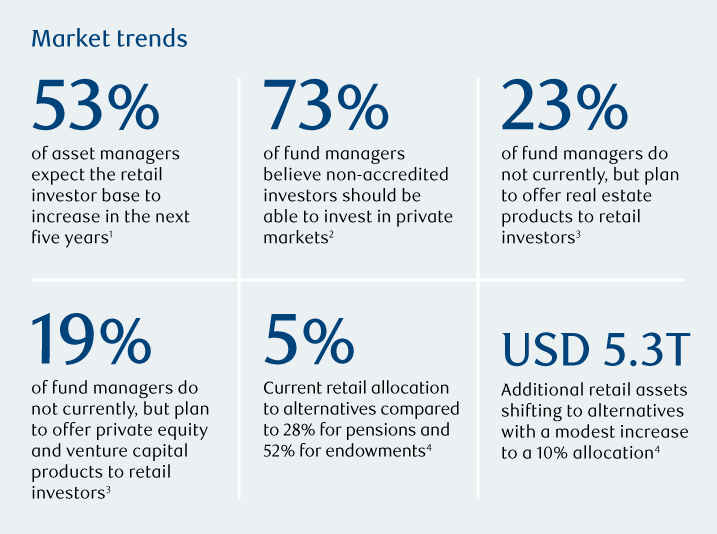As alternative managers increasingly look to retail investors for growth opportunities, it’s essential to consider the unique administrative, liquidity and technology requirements of the retail market—and the optimal distribution route to such an important market. This is the key take-away of a discussion at the recent ALFI Roadshow in New York where Cyril Schopfer, Head of Client Coverage for the US at RBC Investor & Treasury Services, provided his perspectives on the “democratization of private assets” trend.
“We're seeing a mini-revolution in the retail space," says Schopfer. “Most of the larger alternative asset managers are actively looking at this market."
Increasing focus on the retail market is confirmed by industry surveys. A poll conducted by PERE indicates that 53% of alternative fund managers expect retail investors to account for a larger proportion of their assets under management over the next five years,1 while an EY and SEI survey shows that 73% of managers believe non-accredited investors should be able to invest in private markets.2

What’s driving increased interest in the retail market?
Individual investors are attracted to the potential for alternative investments to provide above-average returns in the context of significant public market volatility and portfolio diversification. At the same time, asset managers are seeking to broaden their client base in a highly competitive environment.
Several recent regulatory developments are also supporting retail investor access to alternatives:
- In 2020, the US Securities and Exchange Commission broadened its definition of an accredited investor to allow more investors to participate in private offerings.5
- Recent guidance from the US Department of Labor enables companies to include certain types of managed private equity funds in their 401(k) retirement plans.6
- In 2021, the European Commission unveiled its proposal to amend the first version of the European Long-Term Investment Fund (ELTIF) regulation, greatly improving the flexibility of the vehicle in terms of eligible assets, portfolio composition, distribution, authorization and a reduction in the minimum investment amount from €10,000 to €1,000.7
As alternative managers make plans to enter the massive retail market, there are a number of key points to take into account:
1. Administrative requirements merit special attention
Dealing with a multitude of individual investors can be frustrating for alternative managers. “Big alternative asset managers are set up to handle a small number of large clients," Schopfer says. “It can be a challenge to handle the number of retail investors. All the different reports and forms that need to be read and filled out can be an issue for managers."
Dealing with a multitude of individual investors can be frustrating for alternative managers
According to Schopfer, it’s important for alternative managers to think about the frequency and transparency of reporting, which tends to be more onerous in the retail space. And depending on the structure or where the funds are being distributed, “the authorities may require a specific set of data and documents that are unique to the retail sector.”
2. Liquidity may also be a challenge
Private capital funds are generally closed-ended as investors commit their capital for the duration of the fund. “But retail investors are looking for open-ended or evergreen funds that offer mechanisms for frequent subscriptions and redemptions,” says Schopfer. Managers must ensure that they have the liquidity to support the redemption process.
“Liquidity is typically met by establishing a liquidity sleeve, investing in financial instruments coupled with income-generating private assets. A credit line may also be used to provide for temporary liquidity,” Schopfer adds. “Banks can provide alternative managers with lending facilities, custody and cash management solutions to meet this need.”
3. Technology serves as an important enabler
"New technologies are making it easier for individual investors to participate in the alternative investment arena," Schopfer says, citing master-feeder structures through digital platforms as an example of how investors are being connected directly to alternative managers.
There are also providers that build white label technology solutions for alternative managers or serve as an aggregator to bring retail investors to the manager, he adds. “Other platform providers effectively create a secondary market, allowing investors to buy or sell private funds through their platforms.”
4. Distribution channels revolve around intermediaries
Managers are primarily
looking to access
HNWIs through
intermediaries
“Alternative managers are primarily looking to access high net-worth investors through intermediaries such as financial advisers, wealth managers and private banks,” Schopfer says. Applicable rules can be complex and tend to vary depending on the distribution country and type of product brought to market, he concludes.
The ground is being laid for increased retail participation in the alternative asset sector. However, it’s important for alternative managers to recognize key differences between the retail and institutional markets as managers develop plans to enter the retail space and grow their businesses.

